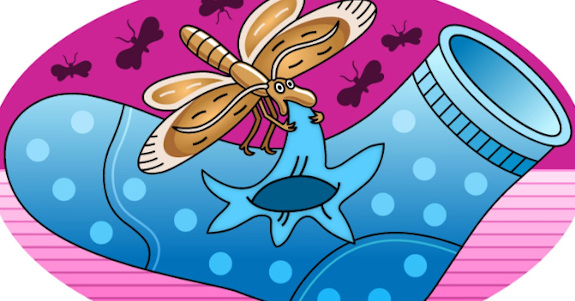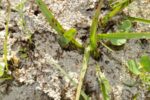
Do Moths Eat Clothes?
If you’ve noticed the little bugs damaging items in your closet, or the adult moths flying around, you’re probably wondering how to get rid of clothes moths. Clothes moths are a common pest in South Florida households, attracted to many items we keep and use every day. While they are most well known for the damage they do to clothing, clothes moths are also attracted to stored foods and grains.
Clothes moths can ruin your first sweater weather day. It’s been warm all year, and finally, you catch a drift of that cool breeze you’ve been craving for months. You go to unpack your cold-weather clothes, excited to wear your favorite sweater, and then you notice it. Tiny holes in the fabric that most certainly were not there when you packed it away last year. The culprit? Likely, it’s clothes moths.
What Do Clothes Moths Look Like?
While you may not notice that your home has a problem with clothes moths until you see damage to your wardrobe, it’s essential to know what they look like so you can spot them before they wreak havoc in your closet.
Clothes moths are tiny, just 6 to 7 millimeters long, though their wingspan can be twice that length. Their hallmark is the red or orange-tinged hair that protrudes from their heads and the translucent yellow-brown wings. Clothes moths have four wings, two on each side, and long antenna that extend from the front of their heads. Their wings may appear feathered or “furry.”
Female clothes moths lay their eggs in dark places, making it nearly impossible to spot them before they hatch. While the eggs hatch into caterpillar-like creatures within a matter of days, they are so small that you most likely won’t notice them for months when they begin to weave their cocoons.
If you notice webs of cocoons inside your house, in the garage, or near entryways, you must seek the opinion of a professional bug service as soon as possible. Doing so will prevent any further damage to your belongings.
Why Do Moths Eat Clothes?
Many people wonder exactly why it is that moths eat clothes, and more importantly, how to get rid of clothes moths. While it is true that moths eat clothing, they are most particularly attracted to certain types of clothing.
First, clothes moths prefer dark, warm, and humid spaces. As South Florida maintains this environment nearly all the time, it makes for the perfect home for clothes moths. Clothes moths may hide and breed in closets and other areas where we forget to clear the cobwebs from often enough.
Clothes moths primarily feed on an animal protein called keratin. So many of our household items that contain these animal fibers are at risk of attack. The immature larva caterpillar of the clothes moth can damages our wool, fur, feathers, silk, leather, furniture, and of course, our clothes. Additionally, they may feed on leather coats or bags. It’s easy for them to feed off cold-weather clothing stored in the back of the closet for months on end undisturbed. What this means is that they can cause extensive damage to your clothing. Sometimes these insects can even get into food or pet food, or even signal that their might be a rodent or animal nest or carcass hidden somewhere in the attic. So it is very important to get an inspection from a professional.
Similarly, if you have wool blankets, cashmere scarves, or down coats and comforters, clothes moths are more than happy to feed off those items as well. If the items have been stored without being washed and still have body odor or food particles on them, they are an even more ideal feeding ground. They can also hide in upholstered furniture and feed off that fabric and cushioning, or in areas where pet hair has accumulated such as near baseboards or air vents.
What Does the Damage from Clothes Moths Look Like?
Before you learn how to get rid of clothes moths, you’ll want to know what the damage they cause looks like. Luckily, it’s relatively easy to spot. If you take a fabric item out of storage and it has small holes in it that you know were not there before, it’s likely clothes moths.
It is rare for just one hole to appear because where there is one clothes moth, there are bound to be countless others. There will typically be many small holes that may become larger as the bugs continue to feed. Similarly, if you start noticing holes in clothing or blankets that you are using that are otherwise unexplained, it may be the result of clothes moth damage. It is important to note, however, that clothes moths prefer to feed on items that are undisturbed, and it is rare for them to eat blankets and clothing that are in frequent use.
Where Do Clothes Moths Come From?
Clothes moths can make their way into your home in a variety of ways, most of which are difficult to avoid. They commonly are brought inside in an infested good, or can make their way in through doors and windows. They may also trail in on pets’ bodies.
Clothes moths can get inside when your purchase used items from thrift stores or garage sales. Things like used couches, blankets, and clothing can carry in the eggs without being noticed. Unfortunately, as they are a common bug, it may be difficult to avoid, mainly because the eggs are almost microscopic and nearly impossible to spot.
You may not know that you have brought clothes moths inside until several months later due to their extended breeding and growth cycles.
How to Get Rid of Clothes Moths
Once you have noticed an infestation, you must learn how to get rid of clothes moths, or else they will continue to damage your items. The outbreak will not resolve itself, and it will not go away on its own. Your best course of action after recognizing a clothes moth infestation is to contact a professional pest control service.
The reason it is crucial to seek the help of a professional instead of trying to solve the problem yourself is because clothes moths often hide in places that are very hard to reach or identify. A professional will know exactly where to look and discuss with you the best method to fully eradicate the infestation. Also, it is very important that the problem is not being misidentified, as there are several other insects that may cause this type of damage, such as silverfish, cricket, cockroach, carpet beetle, and more.
Since the eggs and larvae of clothes moths are so tiny, it’s unlikely that you will be able to spot them and identify the areas that need to be addressed. Please don’t take chances when dealing with a clothes moth infestation, as it could lead to extensive damage to your clothing and belongings. Ensure that the infestation is taken care of the first time by hiring a professional bug treatment service.
How to Prevent Future Clothes Moth Infestations
As clothes moths are difficult to spot, you must do everything you can to prevent future infestations once your home has been cleared of infestation. Prevention methods are not complicated, but they can make all the difference.
First, make sure that there are no holes in your window screens. Clothes moths may make their way inside this way. These moths are attracted to animal fur and feathers, so make sure that there are no bird nests that have made a home in trees, gutters, or on the roof of your house. If you have a chimney or attic, have it inspected to ensure that it is bird and rodent-free.
Next, use at-home prevention methods to protect against future infestations. Mothballs in closets are a good idea; however, be careful that they are out of reach of children and pets. Have all cold-weather clothing and items made from animal products dry cleaned before storing them away. Put all blankets and pillows in the dryer on high heat. It is also recommended that you store clothing and items that will not be used for an extended period of time in air-tight bags or containers. This way, the clothing moths will not be able to enter and feed.
Lastly, make sure that you have a routine bug and pest service inspect and treat your home. The experts at Hulett Environmental Services offer treatment and maintenance plans all-year-round to ensure that your home is protected and free of all insects and pests.
Moth Control Services For Your Home
Hulett Environmental Services offers family and pet-friendly treatment options that are environmentally friendly too. If you believe that you may have a clothes moth infestation, contact us today to schedule an entirely free home inspection with no obligation.
Additionally, we have a free online portal where you can upload images and ask our bug experts for their advice. It is a convenient way to see what the suspected damage may be from the comfort of your home. Once you complete the form, an entomologist will review your information and photos and reach out to you the next business day.
Or, call us today at 866-611-2847 for immediate advice.



